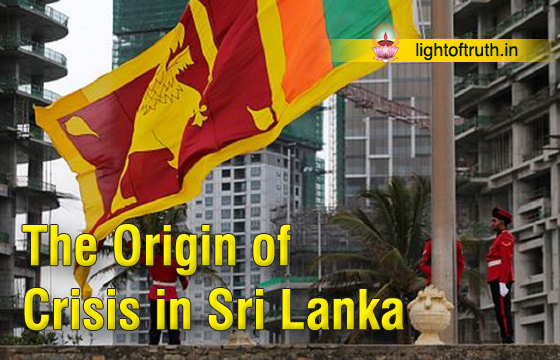Azadi ka Amrit Mahotsav Kolkata event honours four Clergymen
Pope Francis asks businesses to support working women: They’re ‘afraid to get pregnant’
Study: Christianity may lose majority, plurality status in U.S. by 2070
Indian politician declines Magsaysay Award under party pressure
Like John Paul II, Pope Francis heads to Kazakhstan during time of war

Dr Nishant A.Irudayadason
Professor of Philosophy and Ethics, Jnana-Deepa Vidyapeeth, Pune.
For Sri Lanka, the future looks decidedly bleak. On Monday 09 May 2022, clashes between supporters of the Rajapaksa, who has ruled the country since 2019, and anti-government protesters left five dead and more than 225 injured. The Prime Minister, Mahinda Rajapaksa, has just resigned from his post, before being escorted to safety the next day. He will have tried at all costs to recompose his government, after a first assault in front of his residence last month.
Sri Lanka, however, enjoyed good growth at the beginning of the century. Its GDP per capita in 2000 was 2.3 times that of India and three times that of Bangladesh. Today, the country is plunging into a serious economic and social crisis. How did we get here? The controversy surrounding the Rajapaksa clan is not new. To fully understand the situation, it should be remembered that the country was emerging in 2009 from thirty-seven years of a bloody civil war between the Sinhalese and Buddhist majority and the Tamil minority. It was under the leadership of Mahinda Rajapaksa, President from 2005 to 2015 and Prime Minister from 2019 to 2022, that the Tamil freedom fighters were defeated with the help of many countries.
In addition to the brothers’ unclear political past, corruption problems within the government are also at issue. Their other brother, Finance Minister Basil Rajapaksa, is accused of embezzlement of public funds. The opposition even dubbed him “Mr. 10%” in reference to the commissions he allegedly received on government contracts. People also attribute to the government bad political decisions that caused the island’s economic difficulties.
At the end of the war, everything seemed to be well on its way to Sri Lanka. In a logic of strong growth, priority is given to domestic demand through large infrastructure projects. From 2009 to 2015, Mahinda Rajapaksa contracted huge debts, mainly from China, his great ally, to finance them. For many Sri Lankans, these projects symbolize the disastrous management of the government. The same goes for the construction of the International Airport, for which the country borrowed $200 million from China. The terminal is used so little today that its revenues are not even enough to cover its electricity bill. As for the deep-water port of Hambantota, located on the world’s busiest east-west seaway, Rajapaksa’s government was forced to hand it over for 99 years to a Chinese company.
These huge investments are increasing Sri Lanka’s external debt, at least 10% of which has been contracted with Beijing. The two brothers had bet everything on tourism, to the detriment of other sectors. Sri Lanka’s economy today is heavily dependent on tourism. According to the World Bank, direct revenues from international tourism increased for Sri Lanka from $388 million in 2000 to $754 million in 2009 and $5.1 billion in 2018. But by the end of the 2010s, the model began to run out of steam. The pandemic is further hurting the tourism sector. At the same time, other areas that made the wealth of the island are neglected. Exports of textiles, rubber, tea and chemicals, mainly, are abandoned. Their global market shares remain, at best, stable. Rajapaksa’s clan is also losing support from farmers, after the government’s sudden decision to ban chemical fertilizers with no alternatives. Historically, however, they are fervent supporters of the clan.
The situation is getting so worse that in the summer of 2020, Sri Lanka loses access to the international debt market. It announces an external debt of $51 billion in April 2022. The island is now unable to borrow to repay its debt. In reality, this crisis places the island at the heart of the major regional competition between China and India. In May 2021, the Sri Lankan parliament gave the green light for a “Port City” project in Colombo to make a financial hub under the leadership of a Chinese operator ready to invest $ 1.4 billion. This city would be fully tax-free and would accommodate offshore companies, casinos and financial services. Such a project, if realized, would further make Sri Lanka a vassal to China.
Leave a Comment